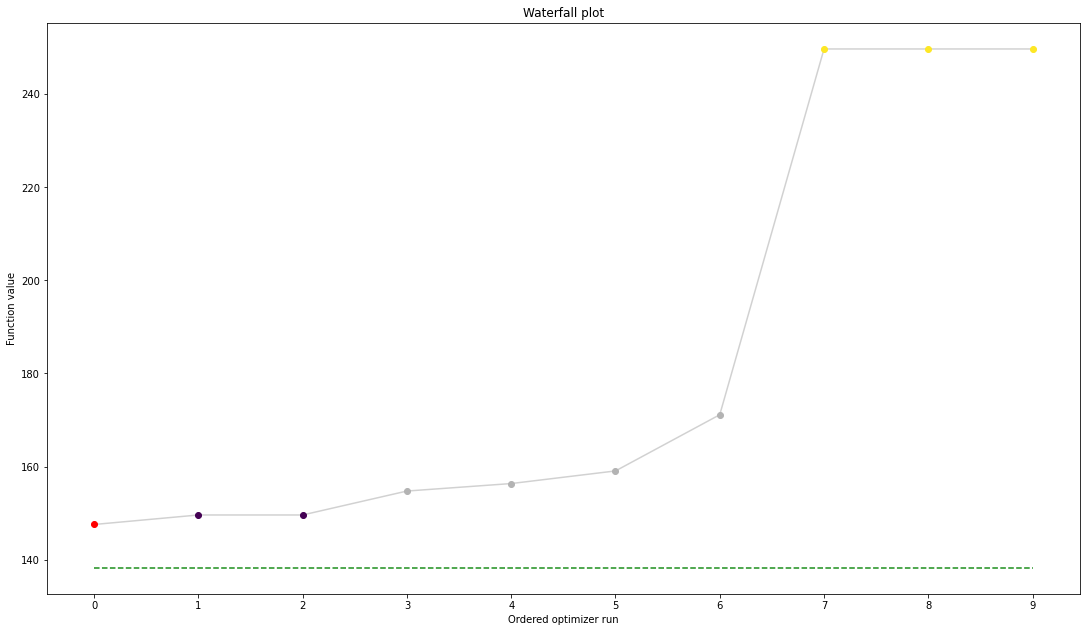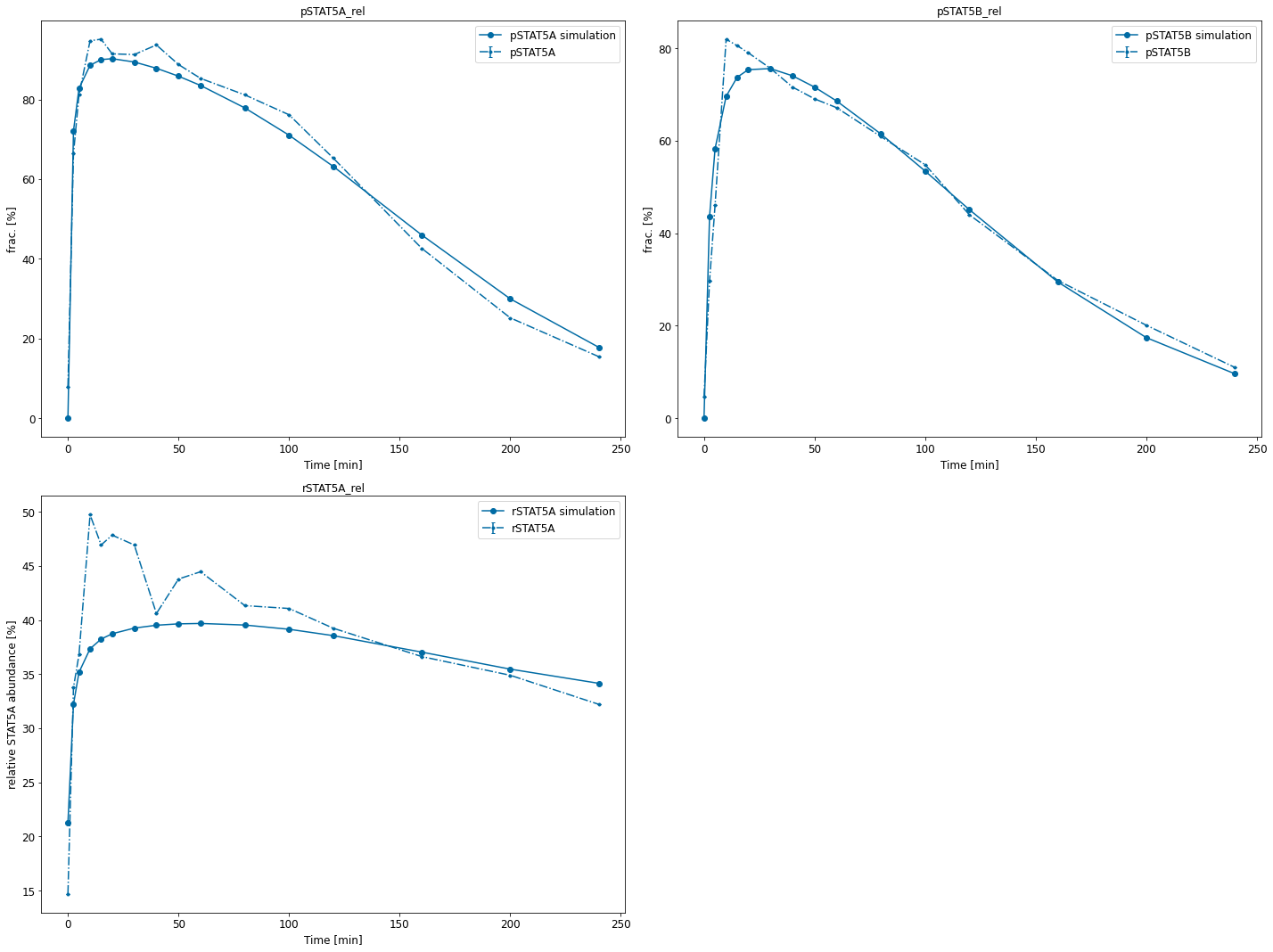Model import using the PEtab format
In this notebook, we illustrate how to use pyPESTO together with PEtab and AMICI. The notebook first details the individual steps of the import and the creation of the objective function. Note that those can steps can be summarised, demonstrated at the end of the ‘Import’ section. After that optimization and visualisation are showcased. We employ models from the benchmark collection, which we first download:
[1]:
# install if not done yet
# !apt install libatlas-base-dev swig
!pip install pypesto[amici,petab] --quiet
!pip install git+https://github.com/Benchmarking-Initiative/Benchmark-Models-PEtab.git@master#subdirectory=src/python --quiet
[2]:
import os
import amici
import benchmark_models_petab as models
import matplotlib.pyplot as plt
import numpy as np
import petab
import pypesto
import pypesto.optimize as optimize
import pypesto.petab
import pypesto.visualize as visualize
Import
Manage PEtab model
A PEtab problem comprises all the information on the model, the data and the parameters to perform parameter estimation. We import a model as a petab.Problem.
[3]:
# a collection of models that can be simulated
# model_name = "Zheng_PNAS2012"
model_name = "Boehm_JProteomeRes2014"
# model_name = "Fujita_SciSignal2010"
# model_name = "Sneyd_PNAS2002"
# model_name = "Borghans_BiophysChem1997"
# model_name = "Elowitz_Nature2000"
# model_name = "Crauste_CellSystems2017"
# model_name = "Lucarelli_CellSystems2018"
# model_name = "Schwen_PONE2014"
# model_name = "Blasi_CellSystems2016"
# the yaml configuration file links to all needed files
yaml_config = os.path.join(models.MODELS_DIR, model_name, model_name + ".yaml")
# create a petab problem
petab_problem = petab.Problem.from_yaml(yaml_config)
Import model to AMICI
The model must be imported to pyPESTO and AMICI. Therefore, we create a pypesto.PetabImporter from the problem, and create an AMICI model.
[4]:
importer = pypesto.petab.PetabImporter(petab_problem)
model = importer.create_model()
# some model properties
print("Model parameters:", list(model.getParameterIds()), "\n")
print("Model const parameters:", list(model.getFixedParameterIds()), "\n")
print("Model outputs: ", list(model.getObservableIds()), "\n")
print("Model states: ", list(model.getStateIds()), "\n")
Model parameters: ['Epo_degradation_BaF3', 'k_exp_hetero', 'k_exp_homo', 'k_imp_hetero', 'k_imp_homo', 'k_phos', 'ratio', 'specC17', 'noiseParameter1_pSTAT5A_rel', 'noiseParameter1_pSTAT5B_rel', 'noiseParameter1_rSTAT5A_rel']
Model const parameters: []
Model outputs: ['pSTAT5A_rel', 'pSTAT5B_rel', 'rSTAT5A_rel']
Model states: ['STAT5A', 'STAT5B', 'pApB', 'pApA', 'pBpB', 'nucpApA', 'nucpApB', 'nucpBpB']
Create objective function
To perform parameter estimation, we need to define an objective function, which integrates the model, data, and noise model defined in the PEtab problem.
[5]:
import libsbml
converter_config = libsbml.SBMLLocalParameterConverter().getDefaultProperties()
petab_problem.sbml_document.convert(converter_config)
obj = importer.create_objective()
# for some models, hyperparamters need to be adjusted
# obj.amici_solver.setMaxSteps(10000)
# obj.amici_solver.setRelativeTolerance(1e-7)
# obj.amici_solver.setAbsoluteTolerance(1e-7)
We can request variable derivatives via sensi_orders, function values or residuals as specified via mode. Passing return_dict, we obtain the direct result of the AMICI simulation.
[6]:
ret = obj(
petab_problem.x_nominal_scaled,
mode="mode_fun",
sensi_orders=(0, 1),
return_dict=True,
)
print(ret)
{'fval': 138.2219980294295, 'grad': array([ 2.20274530e-02, 5.53227528e-02, 5.78847162e-03, 5.39469425e-03,
-4.51595808e-05, 7.91355271e-03, -1.08227697e+02, 1.07805861e-02,
2.40364922e-02, 1.91910805e-02, -1.87147661e+02]), 'rdatas': [<amici.numpy.ReturnDataView object at 0x7fd9001582e0>]}
The problem defined in PEtab also defines the fixed parameters and parameter bounds. This information is contained in a pypesto.Problem.
[7]:
problem = importer.create_problem(obj)
In particular, the problem accounts for the fixation of parameters.
[8]:
print(problem.x_fixed_indices, problem.x_free_indices)
[6, 10] [0, 1, 2, 3, 4, 5, 7, 8, 9]
The problem creates a copy of the objective function that takes into account the fixed parameters. The objective function is able to calculate function values and derivatives. A finite difference checks whether the computed gradient is accurate:
[9]:
objective = problem.objective
ret = objective(petab_problem.x_nominal_free_scaled, sensi_orders=(0, 1))
print(ret)
(138.2219980294295, array([ 2.20274530e-02, 5.53227528e-02, 5.78847162e-03, 5.39469425e-03,
-4.51595808e-05, 7.91355271e-03, 1.07805861e-02, 2.40364922e-02,
1.91910805e-02]))
[10]:
eps = 1e-4
def fd(x):
grad = np.zeros_like(x)
j = 0
for i, xi in enumerate(x):
mask = np.zeros_like(x)
mask[i] += eps
valinc, _ = objective(x + mask, sensi_orders=(0, 1))
valdec, _ = objective(x - mask, sensi_orders=(0, 1))
grad[j] = (valinc - valdec) / (2 * eps)
j += 1
return grad
fdval = fd(petab_problem.x_nominal_free_scaled)
print("fd: ", fdval)
print("l2 difference: ", np.linalg.norm(ret[1] - fdval))
fd: [0.01251672 0.05435043 0.01127778 0.00407248 0.00251655 0.0048468
0.01077928 0.02403519 0.01918978]
l2 difference: 0.011800321299268538
In short
All of the previous steps can be shortened by directly creating an importer object and then a problem:
[11]:
importer = pypesto.petab.PetabImporter.from_yaml(yaml_config)
problem = importer.create_problem()
Run optimization
Given the problem, we can perform optimization. We can specify an optimizer to use, and a parallelization engine to speed things up.
[12]:
optimizer = optimize.ScipyOptimizer()
# engine = pypesto.engine.SingleCoreEngine()
engine = pypesto.engine.MultiProcessEngine()
# do the optimization
result = optimize.minimize(
problem=problem, optimizer=optimizer, n_starts=10, engine=engine
)
Engine set up to use up to 8 processes in total. The number was automatically determined and might not be appropriate on some systems.
Performing parallel task execution on 8 processes.
100%|██████████████████████████████████████████████████████████████████████████████████████████████████████████████████████████████████████████████████████████████████████████████████████████████████████████████████████████████████████████████████████████████████████████████████████████████| 10/10 [00:00<00:00, 297.75it/s]
[Warning] AMICI:CVODES:CVode:ERR_FAILURE: AMICI ERROR: in module CVODES in function CVode : At t = 207.888 and h = 9.53144e-06, the error test failed repeatedly or with |h| = hmin.
[Warning] AMICI:simulation: AMICI forward simulation failed at t = 207.888429:
AMICI failed to integrate the forward problem
[Warning] AMICI:CVODES:CVode:ERR_FAILURE: AMICI ERROR: in module CVODES in function CVode : At t = 207.888 and h = 9.53144e-06, the error test failed repeatedly or with |h| = hmin.
[Warning] AMICI:simulation: AMICI forward simulation failed at t = 207.888429:
AMICI failed to integrate the forward problem
[Warning] AMICI:CVODES:CVode:ERR_FAILURE: AMICI ERROR: in module CVODES in function CVode : At t = 207.888 and h = 9.53144e-06, the error test failed repeatedly or with |h| = hmin.
[Warning] AMICI:simulation: AMICI forward simulation failed at t = 207.888429:
AMICI failed to integrate the forward problem
[Warning] AMICI:CVODES:CVode:ERR_FAILURE: AMICI ERROR: in module CVODES in function CVode : At t = 159.567 and h = 5.63894e-06, the error test failed repeatedly or with |h| = hmin.
[Warning] AMICI:simulation: AMICI forward simulation failed at t = 159.566902:
AMICI failed to integrate the forward problem
[Warning] AMICI:CVODES:CVode:ERR_FAILURE: AMICI ERROR: in module CVODES in function CVode : At t = 159.567 and h = 5.63894e-06, the error test failed repeatedly or with |h| = hmin.
[Warning] AMICI:simulation: AMICI forward simulation failed at t = 159.566902:
AMICI failed to integrate the forward problem
[Warning] AMICI:CVODES:CVode:ERR_FAILURE: AMICI ERROR: in module CVODES in function CVode : At t = 159.567 and h = 5.63894e-06, the error test failed repeatedly or with |h| = hmin.
[Warning] AMICI:simulation: AMICI forward simulation failed at t = 159.566902:
AMICI failed to integrate the forward problem
Visualize
The results are contained in a pypesto.Result object. It contains e.g. the optimal function values.
[13]:
result.optimize_result.fval
[13]:
[147.5446729318192,
149.5885522003661,
150.6716033176283,
158.81214766267092,
164.44212408287493,
249.74595639607963,
249.7459974417437,
249.7459974424775,
249.74599747132623,
260.2697018742319]
We can use the standard pyPESTO plotting routines to visualize and analyze the results.
[14]:
ref = visualize.create_references(
x=petab_problem.x_nominal_scaled, fval=obj(petab_problem.x_nominal_scaled)
)
visualize.waterfall(result, reference=ref, scale_y="lin")
visualize.parameters(result, reference=ref)
[14]:
<AxesSubplot: title={'center': 'Estimated parameters'}, xlabel='Parameter value', ylabel='Parameter'>


We can also conveniently visualize the model fit. This plots the petab visualization using optimized parameters.
[15]:
# we need to explicitely import the method
from pypesto.visualize.model_fit import visualize_optimized_model_fit
visualize_optimized_model_fit(
petab_problem=petab_problem, result=result, pypesto_problem=problem
)
[15]:
{'plot1': <AxesSubplot: title={'center': 'pSTAT5A_rel'}, xlabel='Time [min]', ylabel='frac. [%]'>,
'plot2': <AxesSubplot: title={'center': 'pSTAT5B_rel'}, xlabel='Time [min]', ylabel='frac. [%]'>,
'plot3': <AxesSubplot: title={'center': 'rSTAT5A_rel'}, xlabel='Time [min]', ylabel='relative STAT5A abundance [%]'>}
